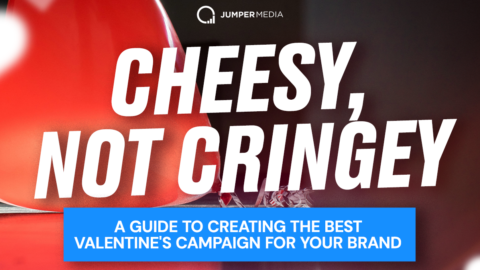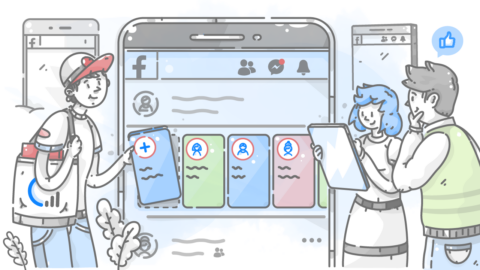92% of Marketers Advertise on Facebook
With that many advertisers actively using the platform, it’s pretty much vital that you make your Facebook ads count. You don’t want to end up spending hundreds or thousands of dollars and seeing minimal returns.
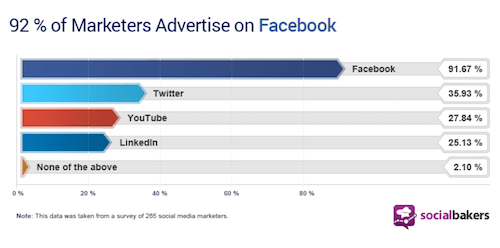
Source
There are two courses of action to get maximum results from an ad:
- Make an ad that is so incredibly amazing that it’s better than everything already out there, or
- Target a really specific set of people who are actively interested in what you’re offering and also at the right stage in the buying cycle.
While the first option sounds tempting, the chances are quite slim that you’ll create the best ad that has ever been made. Instead, targeting is one of the most important aspects of running a successful Facebook Ad campaign.
The struggle comes when you don’t know how to do that targeting.

Of course, you can always target your past customers; they’ve demonstrated their interest in what you do, but there’s a better way.
If you want to grow your customer base outside of the people who have already bought from you, it’s pretty much a must.
Interest-Based Targeting & How to Use It
The best way to have Facebook advertising success is to target people with ads related to what they are already interested in.
But how do you find which interests are the best ones to target so your ads reach the right people?
The great thing about Facebook is it’s a social platform.
People use it to see what’s going on with their friends and to get into heated debates about their favorite shows (not to mention share pictures of their dinner). Most of the time, they have zero interest in your ads, which means it’s up to you to generate some kind of interest.
Showing your ads to people who probably like them seems like a great place to start!

Source
Facebook stores a ton of data about its users, from what pages they like, what posts they comment on the most, and what they’ve spoken about in Facebook Messenger. It uses this information to create a “profile” of each user and it can then determine who’s interested in what and serve them relevant ads.
First things first…
Create a Buyer Persona
Before you can think about the potential interests of your audience, you need to know who your audience is. In the marketing world, this process is known as creating a buyer (or customer) persona, and it helps you speak directly to the kind of people you want to attract.
A buyer persona incorporates generic demographic information like age, gender, and location, but it also digs deeper than that and takes into account psychographic tendencies, too.

This includes the answers to questions like:
- What does your audience struggle with the most?
- What does an average day look like for them?
- Where do they want to be in 10 years time?
- What newspaper do they pick up and read first thing in the morning?
These specifics will help you build a better understanding of who it is you’re targeting and what makes them tick.
Once you’ve created a buyer persona, you can start to find those people and research their key interests. To help you out, we’ve put together a list of the best ways to do that.
1) Tap Into Your Audience Insights
Facebook Insights is probably the easiest way to find out what your audience is interested in, and it doesn’t take much time, either. The only issue is that it can be a generic result for all people in your industry, so if you just use this method, you might find that your competitors are also trying to target the same pool of interests.
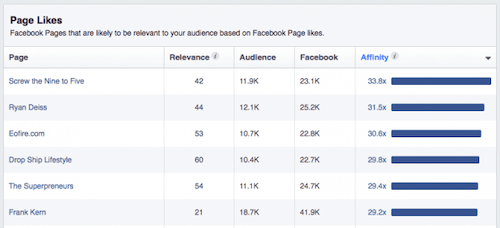
With Insights, you can access general information of your audience, such as age and location but — more interestingly — you can see the kinds of pages they like on Facebook, too.
This will help build a bigger picture of the kinds of topics, brands, and people your audience is into outside of your business.
2) Search Outside of Facebook
While there is a ton of data captured inside Facebook, you can build a better overall picture of what your audience is interested in when you combine the information with data from other sources – like Google.
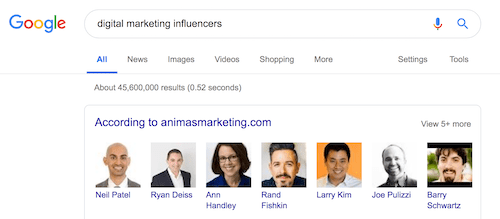
You can use the search engine to find the top brands, products, magazines, blogs, websites, and public figures within your chosen area.
Once you’ve got a list of these different organizations and platforms, you can then plug each one into the Facebook search bar to find a fan page and see whether it has a large audience and is available for targeting.
3) Stalk Your Most Engaged Customers
Sometimes you might find that the same few customers or fans consistently engage with your content or social media updates. If this is the case, you can tap into their interests as it’s highly likely that other people who will also be up for engaging with (and buying from) you have similar interests.
To do this, go to the profiles of these highly-engaged customers and go to their interests/likes. These tend to be publicly available, although you may find that some privacy settings don’t allow you to access this information.
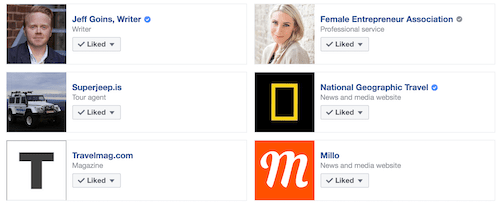
Obviously, you don’t want to target every single one of their interests, but if you’re checking out a few profiles, you might find that there’s some overlap in page likes or that there are a few pages that seem particularly relevant for your audience.
If you don’t seem to have any highly-engaged customers, try checking out your competitors’ pages and see if they have any particularly engaged people you can digitally “stalk.”
Need help managing your company’s Instagram,
getting more followers,
creating awesome social videos, or
optimizing Facebook Ads?
You’ve come to the right place.
Get in touch for a free demo.
4) Use Facebook’s Suggestions
Within your Ads Manager, you’ll notice that there is a pre-filled list of interest categories, ranging from things like “fashion and beauty” to “business and marketing.” When you click an interest area, Facebook will offer similar suggestions using data it’s grabbed from its users.
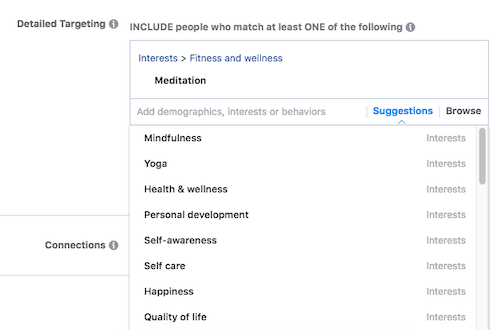
Sometimes this sparks an idea that you otherwise wouldn’t have had. If there’s a specific interest you have in mind, you can type it into the search bar and then you’ll be served with several more similar suggestions.
5) Fan Page Suggestions
Just like Facebook’s Ads Manager serves you similar suggestions when you type in an interest, you can also get inspiration from Facebook’s “suggested pages” feature that crops up when you like a page.
To begin with, you need to find just one page that your audience is likely to be interested in (maybe by using one of the other methods listed here). As soon as you click the “like” button, Facebook will prompt you to like other similar pages.
From there, you can visit the suggested pages and repeat the process over and over again until you’re happy with the different interests you’ve collected.
You might find that after a while the suggestions start to get a bit off-point or you keep seeing the same ones over and over again, but it can be a good way to get an initial insight into the kinds of pages your audience might be interested in.
6) Amazon Search Results
We spoke earlier about getting outside of Facebook and using other sources to determine your audience’s interests, but have you considered Amazon?
The online marketplace actually offers a really unique way to get inside the minds of your audience and to see what they’re actually spending money on (because, you know, Amazon is a place to shop).
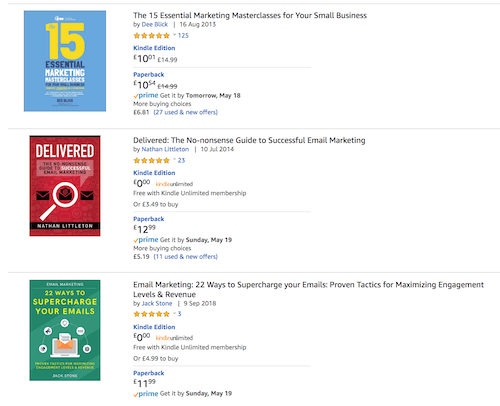
To research on Amazon enter your topic into the search bar in the “books” section. From there, you’ll be served a list of books and authors. It’s the authors you should be particularly interested in here, as these might be influencers that your audience follow.
7) Layer Audience Interests
The key to succeeding with your Facebook targeting is to get as specific as possible, and to do that you ideally need to layer your interests to reach people are similar.
For example, if you are targeting people who are interested in marketing, you can choose the sub-category “search engine marketing” in your Ads Manager, but you might find that’s still too broad.
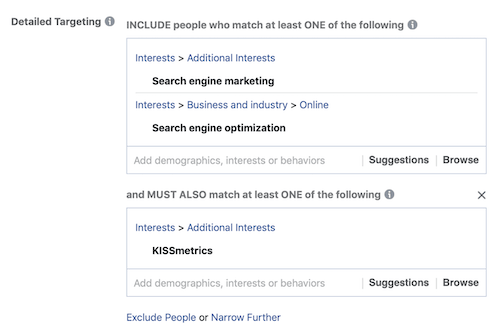
In this case, you can layer other interests over the top, like a specific fan page from a top marketing brand such as KISSmetrics. So, instead of targeting people who Facebook deems to have an interest in digital marketing, you’re targeting people that have both an interest in search engine marketing and like a particular marketing brand.
Take Your Ad Targeting to the Next Level

One of the best things about Facebook advertising is how targeted you can get. There are a wealth of powerful options to target with, from demographics and buying behaviors to interests and specific likes or dislikes.
The more targeted you get with your audience, the more likely you are to reach people that will instantly love your brand and are ready to buy something from you.
Not only does honing in on your audience’s interests mean you can serve them ads that are relevant and seamlessly slip into their newsfeeds, but you can also expand your reach on existing campaigns.
What kind of targeting have you done for your business? Share in the comments below!
For more information click here
